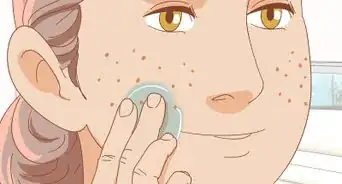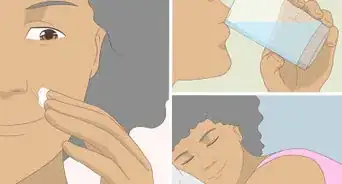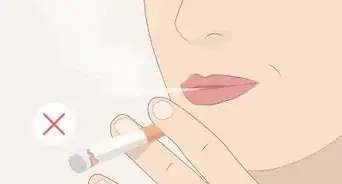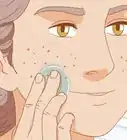This article was co-authored by R. Sonia Batra, MD, MSc, MPH and by wikiHow staff writer, Amy Bobinger. Dr. R. Sonia Batra is a board certified Dermatologist and the Founder of Batra Dermatology based in Los Angeles, California. With over 15 years of experience, Dr. Batra specializes in lasers, medical devices, patient and public medical education, and skin cancer research. She received her Bachelor’s degree, Master’s degree in Public Health, and her Doctor of Medicine (MD) degrees from Harvard University. As a Rhodes Scholar, she earned a Master’s degree in Molecular Genetics at the University of Oxford. She completed her residency training in Dermatology at Stanford University. Dr. Batra has contributed and reviewed for the Journal of Dermatologic Surgery, the Journal of the American Academy of Dermatology, and JAMA Dermatology. She is also a co-host of CBS’ Emmy award-winning television show, The Doctors.
There are 17 references cited in this article, which can be found at the bottom of the page.
wikiHow marks an article as reader-approved once it receives enough positive feedback. In this case, several readers have written to tell us that this article was helpful to them, earning it our reader-approved status.
This article has been viewed 860,566 times.
Your face is the first thing people see, so it only makes sense that you’d want to take good care of it. Everyone’s skin care needs are different, but keeping a consistent routine is essential to caring for your face, no matter what type of skin you have. Also, take the time to treat any particular skin care problems you might struggle with, like acne or especially dry skin. Finally, try to live a healthy lifestyle to keep your skin healthy and glowing!
Steps
Following a Daily Skincare Routine
-
1Wash your face in the morning when you wake up. Every day as soon as you wake up, wash your face with warm water and a gentle cleanser that’s formulated for your skin type. Massage your face using circular motions, but don’t scrub it roughly. Remember, the skin on your face is delicate, so it’s important to wash it gently.[1]
- Avoid using super-hot water to wash your face, as this can dry out your skin.[2]
- If you have sensitive or dry skin, choose a hydrating cleanser. Use a foaming cleanser if you have oily skin, or opt for a salicylic acid-based cleanser if your skin is acne-prone.
-
2Use an alcohol-free toner after you wash your face to balance your skin. Toner helps remove any traces of makeup, dirt, oil, and other impurities from your skin that might be left behind after you wash your face. In addition, it can help balance the pH level of your skin, leaving it healthier and less prone to breakouts.[3]
- Avoid using toners with alcohol, as these can be very drying. Instead, opt for toners made from gentle ingredients like witch hazel or rose water.
Advertisement -
3Use a light moisturizer with SPF each morning. After you wash and tone your face, spread a pea-sized amount of moisturizer over your skin. To protect yourself from the sun, opt for a mineral-based moisturizer (containing zinc oxide or titanium dioxide) with at least SPF 30 and UVA/UVB protection.[4] If you’ll be outdoors where you might sweat heavily, or if you’ll be swimming, plan to reapply your SPF at least every 2 hours.[5]
- Over-exposure to the sun can cause your skin to age prematurely. It can also lead to sun spots, and you’ll be at an increased risk for skin cancer.
- Try to avoid spending time in the sun between 10 a.m. and 4 p.m., as that’s when the rays are the strongest.
- It’s fine to use a separate SPF product if your moisturizer doesn’t offer sun protection.
-
4Opt for non-comedogenic or non-acnegenic cosmetics if you wear them. If you wear makeup, look for products that won’t clog your pores and cause acne. Typically, these products will be labeled as non-comedogenic or non-acnegenic. Most major makeup brands offer these products, including drugstore brands.[6]
Warning: To decrease the risk of skin infection, do not wear expired makeup and don't share makeup with others.
-
5Avoid touching your face throughout the day. When you touch your face, you can transfer oils, dirt, and bacteria to your skin, which can lead to inflammation and irritation. It can be hard, but try to remind yourself to keep your hands away from your face, including not rubbing your eyes or resting your cheek on your hand.[7]
- Wash your hands if you know you’re going to touch your face, like when you’re applying makeup or moisturizer.
-
6Remove your makeup and wash your face at the end of the day. While you should wash always wash your face before bed, it’s especially important if you wear makeup. Makeup can clog your pores, which can lead to blemishes and blackheads. Try taking off your makeup with a face wipe, for instance, then follow that by rinsing your face with a gentle cleanser.[8]
- Don’t rely on makeup remover wipes as your only method of cleansing your face. They contain preservatives and other chemicals that can leave a residue on your skin.
-
7Exfoliate your face once or twice a week. Every few days, dampen a soft washcloth and gently rub all over your face in a circular motion. This will help remove old skin cells from the surface of your face, leaving your skin healthy and glowing. However, if you do it too often, it can damage your skin, which is why you should only exfoliate once a week at first, or twice a week if your skin tolerates it well.[9]
- You can also use facial scrubs or chemical exfoliants if you prefer. You can even make your own facial scrub by mixing a little sugar into your cream cleanser.
-
8Apply a heavier moisturizer before bed. After you wash your face at night, apply a light layer of a thick night cream to hydrate and repair your skin overnight. To get the best results, look for a product that suits your skin type and contains retinol or an alpha hydroxy acid to jumpstart collagen stimulation.[10] However, if you don’t have a separate product on hand, use a plain daytime moisturizer. [11]
- You may also want to apply a separate product to the skin around your eyes for extra lifting and toning, as well as a thick lip balm to keep your lips hydrated and smooth.
-
9Sleep on your back on a clean pillowcase. Try to get in the habit of sleeping on your back as often as possible. If you sleep on your side or your stomach, your face will press against your pillow, which can lead to creases in your skin. It may also lead to fluids pooling beneath your skin, which can make your face look puffy. Over time, sleeping on your side or stomach might even increase your chances of developing wrinkles where your face presses against a pillow.[12]
- If you don’t wash your pillowcase, dirt and oils may increase your chances of having an acne breakout.
- A satin pillowcase may help reduce the risk of developing wrinkles, as your skin will glide more smoothly over the fabric.
Addressing Specific Skincare Concerns
-
1Balance your skin with an occasional face mask. About once a week, use a face mask that’s formulated for your skin type. There are a number of different masks on the market, from clay masks to sheet masks, and each one is designed to target certain skin problems or concerns. Choose the one that’s right for you, and apply it to clean skin. Follow any instructions on the packaging, such as whether to apply the mask to wet or dry skin, how long to leave it on, and how to remove it.[13]
- For instance, if you have dry skin, you might use a nourishing mask made of white clay.
- Try making your own face mask out of natural ingredients like avocado, honey, and oats.
-
2Spot-treat occasional acne with a cream containing benzoyl peroxide. Even if you normally have clear skin, you may get breakouts now and then, especially around the time you get your period. If that happens, visit a drug store or supermarket and pick up a cream with benzoyl peroxide. Apply a little of the cream over the bump 1-2 times a day, being sure to follow any packaging instructions.[14]
- Don't pop your pimples. This can make the infection worse and it may lead to scarring.
- These creams are available over-the-counter, so you won’t need a prescription. However, if you have severe acne, it’s a good idea to see a dermatologist.
-
3Cover dry patches with petroleum jelly or olive oil. If you get dry, flaky patches of skin on your face, moisturizer alone may not be enough to treat them. In that case, cover the patches with a thin layer of petroleum jelly or spread olive oil over the area. This will provide deep moisturizing power, but it will be specifically targeted to your problem areas.[15]
- Don’t attempt to exfoliate the dry patches away, as this can make them worse.
-
4Blot your face throughout the day if you have oily skin. If you’re following a regular skin care routine but you still get oily halfway through the day, try patting your face gently with blotting papers. These papers will lift away oil without disturbing your makeup or over-drying your skin.[16]
Did You Know? Excessive oil may actually be caused by dry skin, as your skin may over-produce oil to try to balance itself.
-
5Tweeze stray hairs to remove them. It’s totally normal to spot stray hairs between your eyebrows, above your top lip, or under your chin. However, if they bother you, it’s fine to tweeze them. Grasp a hair with a sharp pair of tweezers, trying to get as close as you can to the base of the hair. Then, pull the hair sharply in the same direction it’s growing. The hair should slide out by the roots.[17]
- For more widespread facial hair, consider visiting an esthetician for waxing, threading, or bleaching. You can even ask about more permanent procedures like laser hair removal or epilation.
-
6Place cucumbers on your eyes to decrease puffiness. If you notice that the skin under your eyes looks puffy or swollen, lie on your back and placed sliced cucumbers over your eyes for about 15 minutes. The cucumbers will help soothe your eyes while reducing any puffiness. In addition, the time you spend relaxing will help you feel more rested and rejuvenated, which can also show on your skin.[18]
- If you don’t have any cucumbers at home, place 2 spoons in the freezer for about 5 minutes, then place them over your eyes for 10-15 minutes.
-
7Try facial exercises to tone the muscles in your face. Start by poking out your lower lip as far as you can. Hold that for about 30 seconds, then tilt your head down so your chin is pointed at your chest, and stay like that for about 30 seconds as well. Then, look up at the ceiling and push your bottom lip out.[19]
- These exercises will work your facial muscles, which can help your face look more toned and smooth.
Making Lifestyle Changes for Healthier Skin
-
1Drink plenty of water every day. The skin on your face can start to look pale and saggy when you get dehydrated, so it’s important to drink a lot of water every day. While the exact amount of water you should drink will vary based on your activity level, aim to drink about 6-8 glasses of fluids a day.[20]
- One easy way to drink more water is to carry a refillable water bottle with you. That way, you can take a sip whenever you start to feel thirsty!
- If you don’t like plain water, try adding fresh fruits, like strawberries, lemons, or blueberries, to infuse the water with flavor.
-
2Eat a diet rich in fruits and vegetables. Getting the right vitamins and nutrients will leave your skin healthy and glowing. To ensure you’re getting everything you need, try to incorporate healthy foods like fresh fruits, leafy greens, lean proteins, and whole grains into your diet.[21]
- For instance, for lunch you might have tuna fish over fresh greens, a slice of whole-grain bread, and an orange.
- For dinner, try a chicken or tofu stir-fry with a variety of tasty veggies.
- Taking a fish oil supplement each day may also improve the look of your skin.
-
3Exercise for about 30 minutes a day. Regular exercise will help improve your circulation, which will give your skin a healthy, rosy glow. In addition, exercise can help your body flush out toxins, so you may be less likely to have acne or blocked pores.[22]
- Try to find an exercise you enjoy so you’ll be consistent at it. For instance, you might find you’re more likely to exercise if you go jogging, biking, or swimming, or you may prefer playing a sport.
- Quickly towel off or shower after you exercise to prevent sweat from clogging your pores.[23]
-
4Get 8-10 hours of sleep every night if you're a teenager. When you’re tired, it shows on your face, from baggy circles under your eyes to a dull complexion. Try to go to bed at the same time every night, and wake up at the same time each morning. That way, you’ll look your best every day.[24]
- If you’re having trouble sleeping, turn down your thermostat or turn on a fan. The cool air may help you get to sleep faster.
- You need 9-11 hours of sleep if you're between the ages of 6 and 13, 8-10 hours a night if you're between 14 and 17, and 7-9 hours if you're age 18 or older.
-
5Take steps to quit if you’re a smoker. If you smoke, it can be really hard to quit, but if you set a goal for yourself and you’re determined to reach it, you can do it. Try switching to nicotine lozenges or gum, ask your family and friends to help you stay accountable, and have a plan in place for when you get a strong craving. [25]
- There are a number of health risks associated with smoking, including an increased risk of cancer, so quitting is already a good idea. However, smoking also makes your skin look older and paler, and over time, it contributes to wrinkles.
Expert Q&A
-
QuestionI haven't taken good care of my skin before. How can I start?
 R. Sonia Batra, MD, MSc, MPHDr. R. Sonia Batra is a board certified Dermatologist and the Founder of Batra Dermatology based in Los Angeles, California. With over 15 years of experience, Dr. Batra specializes in lasers, medical devices, patient and public medical education, and skin cancer research. She received her Bachelor’s degree, Master’s degree in Public Health, and her Doctor of Medicine (MD) degrees from Harvard University. As a Rhodes Scholar, she earned a Master’s degree in Molecular Genetics at the University of Oxford. She completed her residency training in Dermatology at Stanford University. Dr. Batra has contributed and reviewed for the Journal of Dermatologic Surgery, the Journal of the American Academy of Dermatology, and JAMA Dermatology. She is also a co-host of CBS’ Emmy award-winning television show, The Doctors.
R. Sonia Batra, MD, MSc, MPHDr. R. Sonia Batra is a board certified Dermatologist and the Founder of Batra Dermatology based in Los Angeles, California. With over 15 years of experience, Dr. Batra specializes in lasers, medical devices, patient and public medical education, and skin cancer research. She received her Bachelor’s degree, Master’s degree in Public Health, and her Doctor of Medicine (MD) degrees from Harvard University. As a Rhodes Scholar, she earned a Master’s degree in Molecular Genetics at the University of Oxford. She completed her residency training in Dermatology at Stanford University. Dr. Batra has contributed and reviewed for the Journal of Dermatologic Surgery, the Journal of the American Academy of Dermatology, and JAMA Dermatology. She is also a co-host of CBS’ Emmy award-winning television show, The Doctors.
Board Certified Dermatologist Keep it simple! I like to think of an ABC routine. "A" stands for antioxidants, so use skincare products that contain ferulic acid, Vitamin C, and Vitamin E to repair UV damage. "B" stands for block, so be sure to wear SPF 30 sunscreen. "C" stands for cell turnover or collagen stimulation, so apply a night cream with retinol or an alpha hydroxy acid.
Keep it simple! I like to think of an ABC routine. "A" stands for antioxidants, so use skincare products that contain ferulic acid, Vitamin C, and Vitamin E to repair UV damage. "B" stands for block, so be sure to wear SPF 30 sunscreen. "C" stands for cell turnover or collagen stimulation, so apply a night cream with retinol or an alpha hydroxy acid. -
QuestionHow do I get clear skin and a glowing face?
 Community AnswerCleanse, tone and moisturize your face before putting on any makeup. Wear the minimal amount of makeup, as it clogs your pores and causes a lot of spots. Avoid touching your face -- your fingers are dirty. Cleanse, tone and moisturize again before bed.
Community AnswerCleanse, tone and moisturize your face before putting on any makeup. Wear the minimal amount of makeup, as it clogs your pores and causes a lot of spots. Avoid touching your face -- your fingers are dirty. Cleanse, tone and moisturize again before bed. -
QuestionWhich products should I use daily?
 Community AnswerTry micellar water, toner any type of cleanser and a good face moisturizer.
Community AnswerTry micellar water, toner any type of cleanser and a good face moisturizer.
References
- ↑ https://kidshealth.org/en/teens/skin-tips.html
- ↑ https://www.self.com/story/how-to-wash-your-face
- ↑ https://www.marieclaire.com/beauty/news/a19522/why-you-need-to-use-toner
- ↑ R. Sonia Batra, MD, MSc, MPH. Board Certified Dermatologist. Expert Interview. 14 May 2021.
- ↑ https://www.mayoclinic.org/healthy-lifestyle/adult-health/in-depth/skin-care/art-20048237
- ↑ https://kidshealth.org/en/teens/skin-tips.html
- ↑ https://kidshealth.org/en/teens/skin-tips.html
- ↑ https://www.self.com/story/how-to-wash-your-face
- ↑ https://www.aad.org/public/skin-hair-nails/skin-care/exfoliation
- ↑ R. Sonia Batra, MD, MSc, MPH. Board Certified Dermatologist. Expert Interview. 14 May 2021.
- ↑ https://www.cosmopolitan.com/style-beauty/beauty/advice/a42921/skincare-rituals-of-women-with-beautiful-skin/
- ↑ https://www.cosmopolitan.com/style-beauty/beauty/advice/a42921/skincare-rituals-of-women-with-beautiful-skin/
- ↑ https://www.harpersbazaar.com/uk/beauty/skincare/news/a41160/how-to-apply-face-mask-mistakes/
- ↑ https://kidshealth.org/en/teens/skin-tips.html
- ↑ https://www.marieclaire.com/beauty/news/a24720/how-to-fix-dry-patchy-skin/
- ↑ https://www.self.com/story/skin-always-oily-halfway-through-the-day
- ↑ https://www.goodhousekeeping.com/beauty/anti-aging/a24536/a-gentle-way-to-remove-facial-hair/
- ↑ https://www.healthywomen.org/content/article/how-get-rid-puffy-eyes
- ↑ https://www.marieclaire.co.uk/beauty/how-to/anti-ageing-facial-exercises-94678
- ↑ https://www.nhs.uk/live-well/eat-well/the-eatwell-guide/
- ↑ https://www.mayoclinic.org/healthy-lifestyle/adult-health/expert-answers/healthy-skin/faq-20058184
- ↑ health.com/health/gallery/0,,20909808,00.html
- ↑ R. Sonia Batra, MD, MSc, MPH. Board Certified Dermatologist. Expert Interview. 14 May 2021.
- ↑ https://www.sleepfoundation.org/excessive-sleepiness/support/how-much-sleep-do-we-really-need
- ↑ https://www.mayoclinic.org/healthy-lifestyle/adult-health/in-depth/skin-care/art-20048237
-Step-1-Version-2.webp)
-Step-2-Version-2.webp)
-Step-3-Version-2.webp)

-Step-4-Version-2.webp)
-Step-5-Version-2.webp)
-Step-6-Version-2.webp)
-Step-7-Version-2.webp)
-Step-8.webp)
-Step-9.webp)
-Step-10.webp)
-Step-11.webp)
-Step-12.webp)
-Step-13.webp)
-Step-14.webp)
-Step-15.webp)
-Step-16.webp)
-Step-17.webp)
-Step-18.webp)
-Step-19.webp)
-Step-20.webp)
-Step-21.webp)



























































